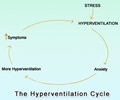
The article is entitled "Breath-By-Breath Analysis of Cardiorespiratory Interaction for Quantifying Developmental Maturity in Premature Infants." It appears in the current edition of the Journal of Applied Physiology, published by the American Physiological Society.
MethodologyThe researchers collected data from the bedside monitors of 1,202 infants cared for in the University of Virginia NICU from January 2009 to June 2011. This data included both electrocardiogram waveforms (an indicator of heartbeats) and chest impedance signals (an indicator of breaths) from both infants considered to have very low birth weights and those with normal birth weights. The researchers paired these two measures in sliding four minute windows, using software to determine whether patterns in breathing correlated with patterns in heartbeats. They also collected other data on these patients, including gestational age at birth (a measure of prematurity), postnatal age (length of time after birth), and age at discharge from the hospital.
ResultsThe researchers were able to gather 34,600 breathing and heartbeat records for the 1,202 patients, corresponding to an average of 13 days of data for each infant. Their results showed that their analytical method was useful for identifying the link between breathing and heartbeat in this population. Findings revealed that cardiorespiratory interaction steadily increased with each infant's postnatal age. Surprisingly, researchers found no correlation between cardiorespiratory interaction and either birth weight or gestational age at birth, two factors often used to gauge infant maturity. The degree of cardiorespiratory interaction increased over time before the attending physician's decision to discharge each baby from the hospital without respiratory support or cardiorespiratory monitoring, suggesting that each infant's brainstem—a critical structure that controls many functions vital to life—was maturing over time.
Importance of the FindingsThese findings suggest that by coupling individual breaths to heartbeats, the researchers were able to avoid the pitfalls of earlier methods. The analytical method used by this research team could be useful for monitoring whether premature infants have developed enough to head home from the hospital without complications.
"Since coupling of organs is correlated with good health, continuously measuring cardiorespiratory interaction may provide early detection of subacute, potentially catastrophic illness. Future studies should test the hypothesis that falling cardiorespiratory interaction precedes clinically evident deterioration," the authors say.
Advertisement
Source-Eurekalert












